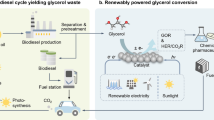Abstract
The recent rapid growth of the biodiesel industry has generated a significant amount of glycerol as a byproduct. As a result, the price of glycerol is currently relatively low, making it an attractive starting material for the production of chemicals with higher values. Crude glycerol can be directly converted through microbial fermentation into various chemicals such as hydrogen. In this study, we optimized immobilization of a facultative hydrogen producing microorganism, Enterobacter aerogenes, with the goal of developing biocatalysts that was appropriate for the continuous hydrogen production from glycerol. Several carriers were tested and agar was found to be the most effective. In addition, it was clearly shown that variables such as the carrier content and cell loading should be controlled for the immobilization of biocatalysts with high hydrogen productivity, stability, and reusability. After optimization of these variables, we were able to obtain reusable biocatalysts that could directly convert the byproduct stream from biodiesel processes into hydrogen in continuous processes.






Similar content being viewed by others
References
Adhikari S, Sandun D, Fernando S, Agus H (2009) Hydrogen production from glycerol: an update. Energy Convers Manag 50:2600–2604
Patrick H, Dipankar G (2009) Advances in fermentative bio-hydrogen production; the way forward. Trends Biotechnol 27:287–297
Ewan BCR, Allen RWK (2005) A figure of merit assessment of the routes to hydrogen. Int J Hydrogen Energy 30:809–819
Tullo A (2006) Firms advance chemicals from renewable resources. Chem Eng News 85:14
Pagliaro M, Ciriminna R, Kimura H, Rossi M, Pina CD (2007) From glycerol to valueadded products. Angew Chem Int 46:4434–4440
Claude S (1999) Research of new outlets for glycerol. Eur J Lipid Sci Technol 101:101–104
Seifert K, Waligorska M, Wojtowski M, Laniecki M (2009) Hydrogen generation from glycerol in bath fermentation process. Int J Hydrogen Energy 34:3671–3678
Jong Hwan S, Tai Hyun P (2006) Biological hydrogen production processes. Korean Chem Eng Res 44:16–22
Patrick CH (2009) Fermentative hydrogen production: principles, progress, and prognosis. Int J Hydrogen Energy 34:7379–7389
Morimoto M, Atsuko M (2004) Biological production of hydrogen from glucose by natural anaerobic microflora. Int J Hydrogen Energy 29:709–713
Sergei AM, Jared A, Waldron B (2011) Bioreactor for glycerol conversion into H2 by bacterium Enterobacter aerogenes. Int J Hydrogen Energy 36:262–266
Guillaume SP, Patrick CH (2009) High yield conversion of a crude glycerol fraction from biodiesel production to hydrogen by photofermentation. Bioresour Technol 100:3513–3517
Vassilev N, Toro M, Vassileva M (1997) Rock phosphate solubilization by immobilized cells of Enterobacter sp. in fermentation and soil conditions. Bioresour Technol 61:29–32
Yokoi H, Ohkawara T (1995) Characteristics of hydrogen production by aciduric Enterobacter aerogenes strain HO-39. J Ferment Bioeng 80:481–484
Ito T, Ankashimada Y (2005) Hydrogen and ethanol production from glycerol-containing wastes discharged after biodiesel manufacturing process. J Biosci Bioeng 100:260–265
Malvessi E, Carra S, Mauricio MDS, Marco AZA (2010) Effect of substrate concentration, pH and temperature on the activity of the complex glucose-fructose oxidoreductase/glucono-∂-lactonase present in calcium alginate-immobilized Zymomonas mobilis cells. Biochem Eng J 51:1–6
Sonomoto K, Chinachoti N, Naoyuki E, Ayaaki I (2000) Biosynthetic production of nisin Z by immobilized Lactococcus lactis IO-1. J Mol Catal B Enzym 10:325–334
Sunhee P (1987) Hydrogen production by Rhodopseudomonas spp. immobilized. Ewhas Womans University, Seoul
Para G, Baratti J (1988) Synthesis of l-Dopa by Escherichia intermedia cells immobilized in a carrageenan gel. Enzym Microb Technol 10:729–735
Castillo E, Rodriguez M, Casas L, Quintero R, Ldpez-Munguia A (1991) Design of two immobilized cell catalysts by entrapment on gelatin: internal diffusion aspects. Enzym Microb Technol 13:127–133
Kennedy JF, Kalogerakis B, Cabral JMS (1984) Surface immobilization and entrapping of enzymes on glutaraldehyde crosslinked gelatin particles. Enzym Microb Technol 6:127–131
Champagne PP, Ramsay JA (2010) Dye decolorization and detoxification by laccase immobilized on porous glass beads. Bioresour Technol 101:2230–2235
Emine K, Sule P (2009) Immobilization of apricot pectinesterase (Prunus armeniaca L.) on porous glass beads and its characterization. J Mol Catal B Enzym 56:13–19
Rebecca C, Hany A, Isabelle G, Rahul B, Mansel G, Michael AB (2010) Immobilization of bacteriophages on modified silica particles. J Biomater 31:1904–1910
Ji Hye J, Dae Sung L, Donghee P, Woo-Seok C, Jong P (2008) Optimization of key process variables for enhanced hydrogen production by Enterobacter aerogenes using statistical methods. Bioresour Technol 99:2061–2066
Yandi D, Abhishek M, Ramon G (2006) Anaerobic fermentation of glycerol by Escherichia coli: a new platform for metabolic engineering. Biotechnol Bioeng 10:821–829
Sung Hun P, Kyn Ho K, Eui-Young K (2008) Analysis of hydrogen production by mixed culture with Enterobacter aerogenes and Clostridium butyridium. Korean J Biotechnol Bioeng 3:216–218
Mike R, Francesco R, Françoise Q (2011) Natural materials with high surface area. Physisorption methods for the characterization of the texture and surface of polysaccharide aerogels. Microporous Mesoporous Mater 140:9–16
Acknowledgments
This work was financially supported by the Eco-Technopia 21 project (2009-03002-002-0) of Ministry of Environment, Korea and by the Basic Research Program of Korea Institute of Industrial Technology.
Author information
Authors and Affiliations
Corresponding authors
Rights and permissions
About this article
Cite this article
Han, J., Lee, D., Cho, J. et al. Hydrogen production from biodiesel byproduct by immobilized Enterobacter aerogenes . Bioprocess Biosyst Eng 35, 151–157 (2012). https://doi.org/10.1007/s00449-011-0593-0
Received:
Accepted:
Published:
Issue Date:
DOI: https://doi.org/10.1007/s00449-011-0593-0




